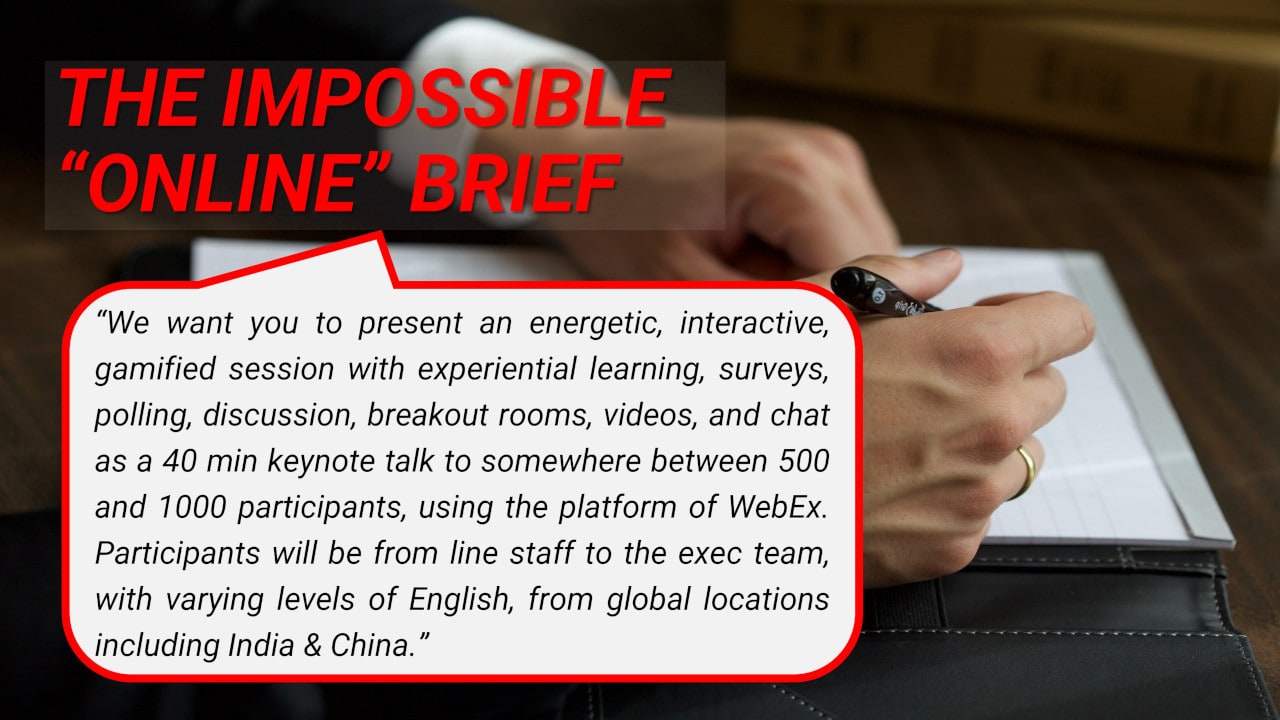THE BRIEF -Can you spot the challenges? If not please read on…..
“We want you to present an energetic, interactive, gamified session with experiential learning, surveys, polling, discussion, breakout rooms, videos, and chat > for a 40 min keynote talk to somewhere between 500 and 1000 participants using the platform of WebEx. Participants will be from line staff to the exec team, with varying levels of English, and from global locations including India and China.”
The disconnect dilemma
Both face to face (classroom-based) conferences, keynote talks, team building, experience-based simulations) AND remote digital platform delivery (Zoom MS Teams etc virtual-based) have their pros and cons. It is essential to know when to use what, the differences, along with the pros and cons of each. Since Covid, many companies facilitators, presenters, consultant and trainers, were forced to move all their content to deliver through a virtual remote online platform. To ensure a successful online learning session, it is as important as setting up a professional face-to-face workshop/keynote/conference.
All outcomes and parameters need to be considered.
The successful ones make it look easy, but this should not discount the pre-work invested of an experienced team to pull this off. The time needs to be taken to make sure everything that is created online is still educationally sound, so the learning lasts. All stakeholders including the designer, facilitator, and organizer, logistics, IT, need to understand the implications of many variables. (This is often why it’s hard to design and propose a session and even quote until all the variables are nailed down.)
Often there is a disconnect between a conference organizer who is focused on the outcomes (and getting as much value as possible from a session), and the limitations and parameters of the available technical platform, (and available time) relative to the group size and outcomes.
Sometimes it’s too late by the time the company’s IT department is called in to make it all happen. Even worse – the presenter is told they can use Zoom (and so have designed an interactive session for Zoom, only to find out 5 mins into the actual session that the company for security reasons has disabled breakout-rooms, no Zoom chat function, and there is a 30 sec delay (cant be interactive). Some countries like China have banned Google / Youtube & other apps, so any participants coming in from there will be restricted.
IF in this case the session depended on interaction, discussion, polling, distributing information, codes, URLS via the chat function during the session, and now cant, then everything is jeopardized, leaving the presenter looking disorganized and the participants in limbo.
This PDF below is to help organisers walk through how to ensure the best session and to ask that all stakeholders get together as soon as possible to know the parameters (restrictions and limitations of any IT logistics / platforms) and then prioritise the outcomes. In the above brief regardless of the presenters skills set and set up,– a few things would have to be sacrificed / prioritised to find a workable solution.
How to successfully transition to Facilitated Online Learning Experiences’ (FOEx)?
- To successful transition to digital requires all content and methods to be redesigned as interactive online sessions. A straight transfer of the content to a digital platform is not good enough. It requires a behind-the-scenes redesign to ensure a similar level of engagement as a good face-to-face session. It’s important to differentiate the specially designed digital delivery, and not think that a straight ‘talking head’ using ‘PowerPoint slides’ focusing on more traditional content delivery will be effective online. (they are barely effective face to face)
- We know that if clients are going to pay for an outside presenter, they want something that will significantly lift their online conference experience &/or learning achievement. Core sessions can be successfully transferred using a wide range of tools (including simulations and gamification) to ensure the audience is fully engaged in the session. No learning takes place if the participants are not self-motivated to learn. But equally, a presenter should not fall into the trap and assume participants are as passionate as they are about the topic.
- As dedicated educators, we have been working hard over the last few months to design a new innovative style of “session” we are calling ‘Facilitated Online Learning Experiences’ (FOEx). This new delivery style will enable participants to successfully transition from their pre-COVID face-to-face conference/ keynotes and classroom-based workshop experiences to an online virtual version, which provides all the rich additional opportunities this platform can offer.
How to get the best out of a digital online session.
The PDF we have created is for conference organizers to consider during engaging a presenter to deliver an online session, webinar or facilitated online experience.
Download now the PDF ‘How to get the best out of a digital online session’
- The disconnect dilemma
- What’s the difference: Online, Webinars, LMS’s and other options?
- How to successfully transition to Facilitated Online Learning Experiences’ (FOEx)?
- Since Covid 19 I’m sure you have seen the flood of consultants and speakers offering content free webinars, team games etc – how does this affect fee structure?
- PROS of digital online V live classrooms:
- CONS of digital online V live classrooms:
- The best of both: Blended Learning
- How to overcome the ‘cons’ (challenges) of virtual digital online sessions
- How to not let the tail wag the dog?
- How to best choose the best numbers of participants?
- How to design for mega groups 200-2000
- What goes on behind a workshop (or even a short 30 min keynote)?
- How to ensure the best Platform:
- Why digital sessions need extra roles such as a moderator and a co-host?
- 15. What could go wrong? Discover this now and plan for it.
The best of online learning
We are big believers of the importance of learning through interaction, dialogue, facilitation and experiential learning, but when face to face interaction becomes a challenge, or is not sufficient: we have designed digital opportunities, with pre and post blended learning.
The Paradox of Virtual Events. Will the platform actually work for large groups &/or interactivity?


